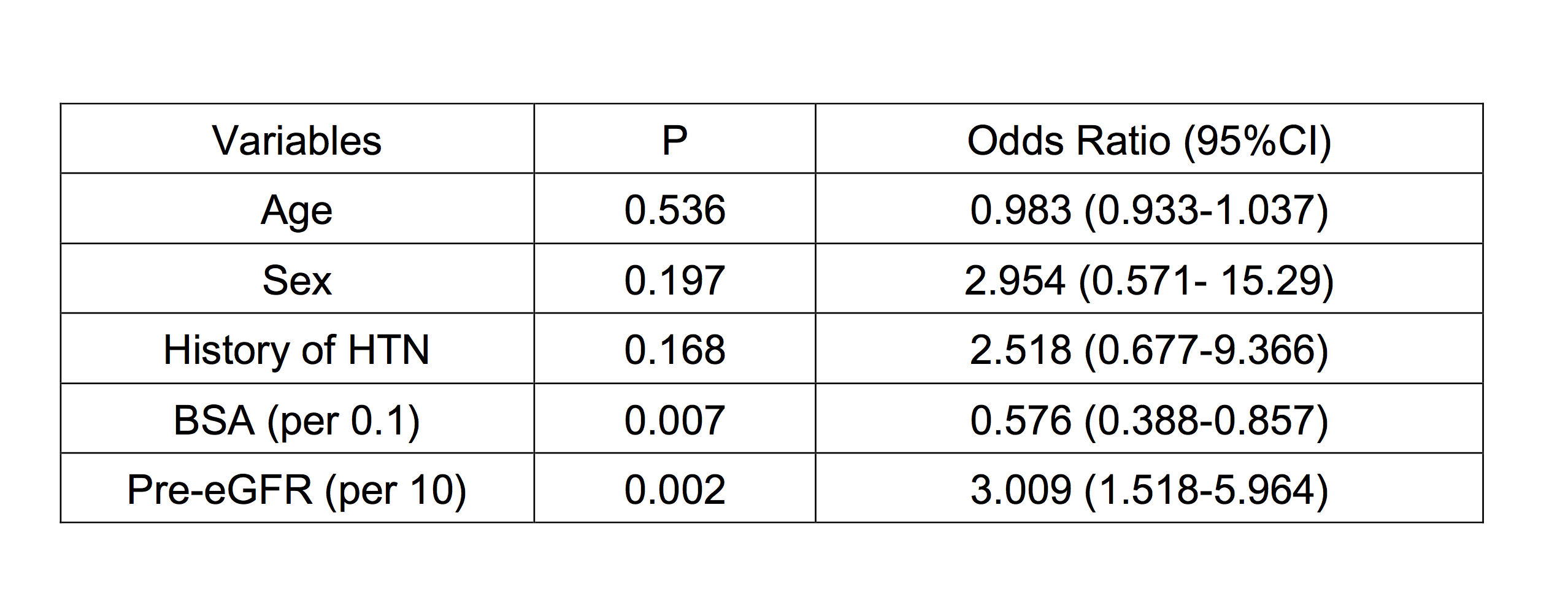Hypertrophy Prediction Model for Contralateral Kidney after Living Donation
1Department of Surgery, University of Pittsburgh, Pittsburgh, PA, 2Department of Surgery, Japanese Red Cross Kumamoto Hospital, Kumamoto, Japan, 3Department of Nephrology, Japanese Red Cross Kumamoto Hospital, Kumamoto, Japan, 4Department of Urology, Japanese Red Cross Kumamoto Hospital, Kumamoto, Japan
Meeting: 2019 American Transplant Congress
Abstract number: B257
Keywords: Kidney transplantation, Outcome, Renal function
Session Information
Session Name: Poster Session B: Kidney Living Donor: Quality and Selection
Session Type: Poster Session
Date: Sunday, June 2, 2019
Session Time: 6:00pm-7:00pm
 Presentation Time: 6:00pm-7:00pm
Presentation Time: 6:00pm-7:00pm
Location: Hall C & D
*Purpose: Compensation of contralateral kidney function is well established and many factors have been proposed as risk factors. There is no prediction model to estimate hypertrophy. The aim of this study was to establish the tool to estimate hypertrophy for contralateral kidney after living donation.
*Methods: We performed retrospective analysis of 133 living donors in renal transplant in our institution. We defined “hypertrophy” as post donation eGFR at one year (CKD-EPI equation) which is more than 60% of pre donation eGFR (pre-eGFR). We analyzed clinical characteristics and outcomes of patients.
*Results: Median (IQR) donor age was 59 (51-65), median(IQR) BMI was 22.9 kg/m2 (20.9-25.2), and median(IQR) Body surface area (BSA) was 1.6m2 (1.5-1.7). All the donors were Japanese and 73% of donors were biologically related. Median (IQR) donor pre-eGFR was 108.7 ml/min/1.73m2 (99.9-115.5). Post donation eGFR at one year was 91.1ml/min/1.73m2 (65.1-103.9). 86% of donors had hypertrophy. In univariate analysis, age, history of hypertension, BSA, pre-eGFR were significantly associated with hypertrophy (P<0.05). In multivariate analysis, BSA and pre-eGFR were significantly associated with hypertrophy (P<0.05). Based on this result, we created a hypertrophy prediction score.
*Conclusions: This prediction score might be useful tool to predict hypertrophy of contralateral kidney. If hypertrophy prediction score was low, careful management and follow-up might be necessary. Further investigations are needed to validate in large population.
To cite this abstract in AMA style:
Okumura K, Tanaka K, Hidaka Y, Toyoda M, Uekihara S, Inadome A, Yokomizo H, Yamanaga S. Hypertrophy Prediction Model for Contralateral Kidney after Living Donation [abstract]. Am J Transplant. 2019; 19 (suppl 3). https://atcmeetingabstracts.com/abstract/hypertrophy-prediction-model-for-contralateral-kidney-after-living-donation/. Accessed December 29, 2025.« Back to 2019 American Transplant Congress

